Extreme Science: Launching Sounding Rockets From The Arctic
Extreme Science: Launching Sounding Rockets from The Arctic
This winter, our scientists and engineers traveled to the world’s northernmost civilian town to launch rockets equipped with cutting-edge scientific instruments.

This is the beginning of a 14-month-long campaign to study a particular region of Earth’s magnetic field — which means launching near the poles. What’s it like to launch a science rocket in these extreme conditions?

Our planet is protected by a natural magnetic field that deflects most of the particles that flow out from the Sun — the solar wind — away from our atmosphere. But near the north and south poles, two oddities in Earth’s magnetic field funnel these solar particles directly into our atmosphere. These regions are the polar cusps, and it turns out they’re the ideal spot for studying how our atmosphere interacts with space.

The scientists of the Grand Challenge Initiative — Cusp are using sounding rockets to do their research. Sounding rockets are suborbital rockets that launch to a few hundred miles in altitude, spending a few minutes in space before falling back to Earth. That means sounding rockets can carry sensitive instruments above our atmosphere to study the Sun, other stars and even distant galaxies.
They also fly directly through some of the most interesting regions of Earth’s atmosphere, and that’s what scientists are taking advantage of for their Grand Challenge experiments.

One of the ideal rocket ranges for cusp science is in Ny-Ålesund, Svalbard, off the coast of Norway and within the Arctic circle. Because of its far northward position, each morning Svalbard passes directly under Earth’s magnetic cusp.
But launching in this extreme, remote environment puts another set of challenges on the mission teams. These launches need to happen during the winter, when Svalbard experiences 24/7 darkness because of Earth’s axial tilt. The launch teams can go months without seeing the Sun.

Like for all rocket launches, the science teams have to wait for the right weather conditions to launch. Because they’re studying upper atmospheric processes, some of these teams also have to wait for other science conditions, like active auroras. Auroras are created when charged particles collide with Earth’s atmosphere — often triggered by solar storms or changes in the solar wind — and they’re related to many of the upper-atmospheric processes that scientists want to study near the magnetic cusp.

But even before launch, the extreme conditions make launching rockets a tricky business — it’s so cold that the rockets must be encased in styrofoam before launch to protect them from the low temperatures and potential precipitation.

When all is finally ready, an alarm sounds throughout the town of Ny-Ålesund to alert residents to the impending launch. And then it’s up, up and away! This photo shows the launch of the twin VISIONS-2 sounding rockets on Dec. 7, 2018 from Ny-Ålesund.

These rockets are designed to break up during flight — so after launch comes clean-up. The launch teams track where debris lands so that they can retrieve the pieces later.

The next launch of the Grand Challenge Initiative is AZURE, launching from Andøya Space Center in Norway in April 2019.
For even more about what it’s like to launch science rockets in extreme conditions, check out one scientist’s notes from the field: https://go.nasa.gov/2QzyjR4

For updates on the Grand Challenge Initiative and other sounding rocket flights, visit nasa.gov/soundingrockets or follow along with NASA Wallops and NASA heliophysics on Twitter and Facebook.
@NASA_Wallops | NASA’s Wallops Flight Facility | @NASASun | NASA Sun Science
More Posts from Ocrim1967 and Others



Saturn, Dione, Rhea, and Epimetheus & Saturn and Enceladus.
Credit: NASA/JPL-Caltech/SSI/CICLOPS/Kevin M. Gill

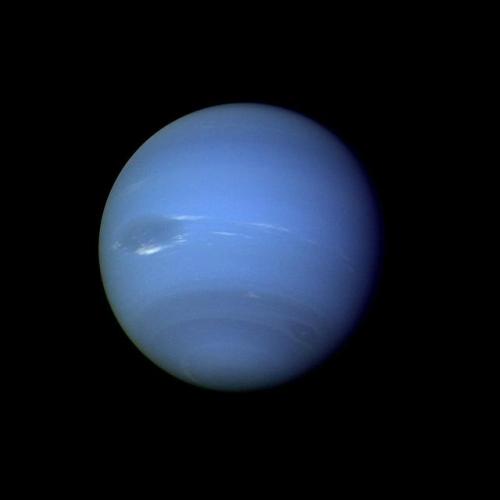
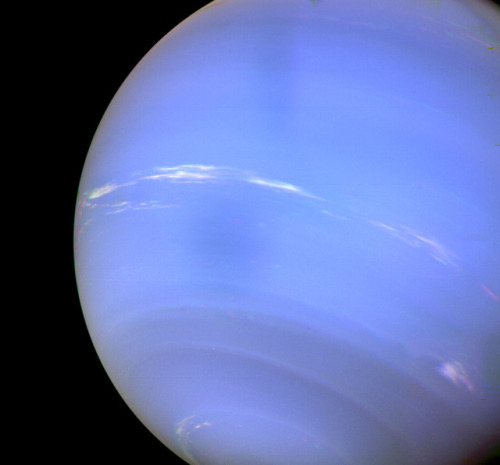
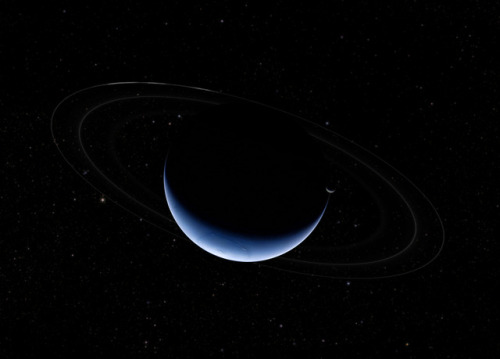
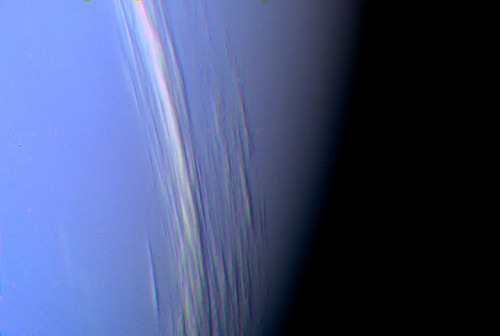
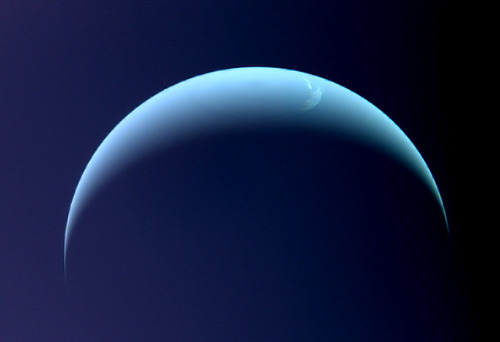
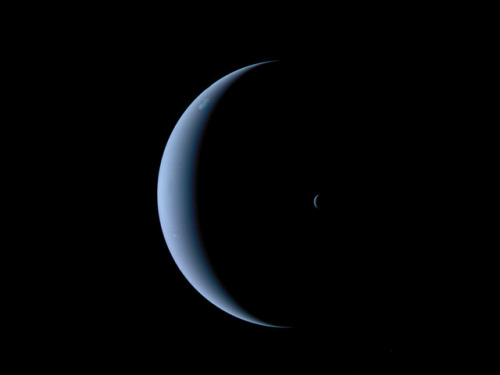
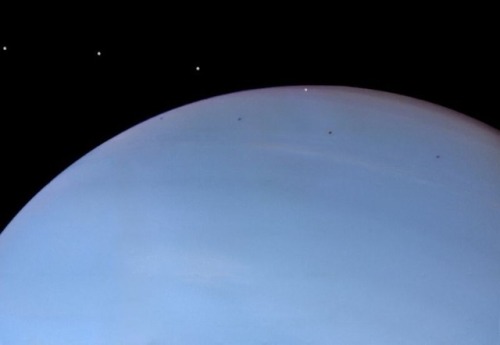
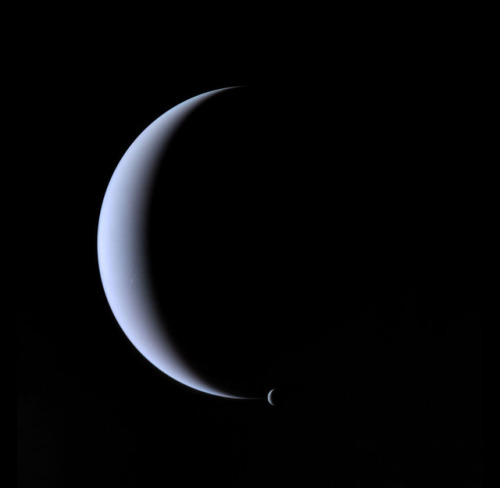
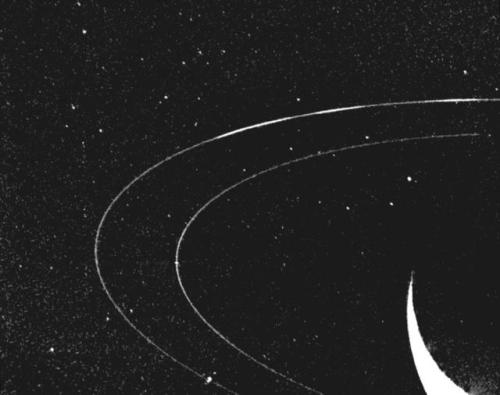
Neptune ♆
On this day in 1846 was discovered the planet Neptune.
The ice giant Neptune was the first planet located through mathematical predictions rather than through regular observations of the sky. (Galileo had recorded it as a fixed star during observations with his small telescope in 1612 and 1613.) When Uranus didn’t travel exactly as astronomers expected it to, a French mathematician, Urbain Joseph Le Verrier, proposed the position and mass of another as yet unknown planet that could cause the observed changes to Uranus’ orbit. After being ignored by French astronomers, Le Verrier sent his predictions to Johann Gottfried Galle at the Berlin Observatory, who found Neptune on his first night of searching in 1846. Seventeen days later, its largest moon, Triton, was also discovered.
Neptune is invisible to the naked eye because of its extreme distance from Earth. Interestingly, the highly eccentric orbit of the dwarf planet Pluto brings Pluto inside Neptune’s orbit for a 20-year period out of every 248 Earth years. Pluto can never crash into Neptune, though, because for every three laps Neptune takes around the Sun, Pluto makes two. This repeating pattern prevents close approaches of the two bodies.
Nearly 4.5 billion kilometers (2.8 billion miles) from the Sun, Neptune orbits the Sun once every 165 years.
Uranus’ blue-green color is also the result of atmospheric methane, but Neptune is a more vivid, brighter blue, so there must be an unknown component that causes the more intense color.
Despite its great distance and low energy input from the Sun, Neptune’s winds can be three times stronger than Jupiter’s and nine times stronger than Earth’s.
Winds on Neptune travel faster than the speed of sound.
In 1989, Voyager 2 tracked a large, oval-shaped, dark storm in Neptune’s southern hemisphere. This “Great Dark Spot” was large enough to contain the entire Earth.
Neptune has five known rings. Voyager 2’s observations confirmed that these unusual rings are not uniform but have four thick regions (clumps of dust) called arcs. The rings are thought to be relatively young and short-lived.
Neptune has 14 known moons, six of which were discovered by Voyager 2.
Triton, Neptune’s largest moon, orbits the planet in the opposite direction compared with the rest of the moons, suggesting that it may have been captured by Neptune in the distant past.
To know more about the planet Neptune click here and here.
Images credit: NASA/JPL- Caltech (some images processed by Kevin M. Gill)









this cat is so cute
WHO IS HE?
In Genesis, He is the seed of the woman. In Exodus, He is the Passover Lamb. In Leviticus, He is our High Priest. In Numbers, He is pillar of cloud by day and a pillar of fire by night. In Deuteronomy, He is the prophet like unto Moses. In Joshua, He is the captain of our salvation. In Judges, He is our judge and lawgiver. In Ruth, He is our kinsman redeemer. In I and II Samuel, He is our trusted prophet. In Kings and Chronicles, He is our reigning king. In Erza, He is our faithful scribe. In Nehemiah, He is the rebuilder of the broken down walls of human life. In Ester, He is our Mordecai. In Job, He is our ever-living redeemer: “For I know my redeemer lives.” In Psalms, He is our shepherd. In Proverbs and Ecclesiastes, He is our wisdom. In Song of Solomon, He is the lover and the bridegroom. In Isaiah, He is the prince of peace. In Jeremiah, He is the righteous branch. In Lamentations, He is the weeping prophet. In Ezekiel, He is the wonderful four-faced man. In Daniel, He is the fourth man walking in the midst of the burning fiery furnaces of life. In Hosea, He is the husband forever married to the backslider. In Joel, He is the mighty baptizer in the Holy Ghost. In Amos, He is my burden bearer. In Obadiah, He is mighty to save. In Jonah, He is God’s great foreign missionary. In Micah, He is the messenger of beautiful feet. In Nahum, He is the avenger of God’s elect. In Habakkuk, He is God’s evangelist, crying, “Revive thy work in the midst of the years.” In Zephaniah, He is our Savior. In Haggai, He is the restorer of the lost heritage of Israel. In Zechariah, He is fountain opened up on the house of David for sin and uncleanness. In Malachi, He is the Son of Righteousness arisen with healing in His wings. In Matthew, He is the Messiah. In Mark, He is the wonder worker. In Luke, He is the Son of Man. In John, He is the Son of God. In Acts, He is the mighty baptizer in the Holy Ghost. In Romans, He is my justifier. In Corinthians, He is my sanctifier. In Galatians, He is the redeemer from the curse of the law. In Ephesians, He is the Christ of unsearchable riches. In Philippians, He is the God that supplies all my needs. In Colossians, He is the fullness of the godhead bodily. In I and II Thessalonians, He is my soon-coming King! In I and II Timothy, He is the mediator between God and man. In Tidus, He is my faithful pastor. In Philemon, He is the friend that sticketh closer than a brother. In Hebrews, He is the blood of the everlasting covenant. In James, He is our Great Physician, for “the prayer of faith shall save the sick.” In I and II Peter, He is my good shepherd. In I John, He is love. In II John, He is love. In III John, He is love. In Jude, He is the Lord coming with 10,000 of His saints. In Revelation, He is King of Kings and Lord of Lords.
HE IS THE WORD OF GOD.










How Quantum Physics Allows Us To See Back Through Space And Time
"If it weren’t for this rare transition, from higher energy spherical orbitals to lower energy spherical orbitals, our Universe would look incredibly different in detail. We would have different numbers and magnitudes of acoustic peaks in the cosmic microwave background, and hence a different set of seed fluctuations for our Universe to build its large-scale structure out of. The ionization history of our Universe would be different; it would take longer for the first stars to form; and the light from the leftover glow of the Big Bang would only take us back to 790,000 years after the Big Bang, rather than the 380,000 years we get today.
In a very real sense, there are a myriad of ways that our view into the distant Universe — to the farthest reaches of deep space where we detect the earliest signals arising after the Big Bang — that would be fundamentally less powerful if not for this one quantum mechanical transition. If we want to understand how the Universe came to be the way it is today, even on cosmic scales, it’s remarkable how subtly dependent the outcomes are on the subatomic rules of quantum physics. Without it, the sights we see looking back across space and time would be far less rich and spectacular."
What gives the Universe the properties we see today? Is it gravity, working on the largest of cosmic scales? It plays a role, but perhaps ironically, the subatomic physics that governs electron transitions within atoms is maybe even more important.
This is how quantum physics allows us to see as far out in space and as far back in time as we can. Without it, our Universe would be a very different place.





Read Full Article Here: 6 Tricks to Staying Positive - Psych2Go
Follow @psych2go for more


Gif by Satiricon

Earth as viewed from 10,000 miles. In 1969, the Apollo 4 unmanned test flight made a great ellipse around Earth as a test of the translunar motors and of the high speed entry required of a manned flight returning from the moon. A 70mm camera was programmed to look out a window toward Earth, and take a series of photographs from “high apogee”. Coastal Brazil, Atlantic Ocean, West Africa, Antarctica, looking west. This photograph was made when the Apollo 4 spacecraft, still attached to the S-IVB (third) stage, was orbiting Earth at an altitude of 9,544 miles. source











Why 2020 Might Be The Best Geminid Meteor Shower Of All-Time
“As the large parent body of the Geminids, asteroid 3200 Phaethon, continues on its tight orbit around the Sun, it will continue to expel matter and be torn apart, bit by tiny bit. The asteroid is about the size of the one that struck Earth 65 million years ago, causing our last great mass extinction. But instead of colliding with us all at once, this ~6 km wide asteroid is slowly dissipating in the presence of the Sun, creating tails of matter and ions but also an ever-thickening debris stream.
With each mid-December that rolls past, Earth slams through that debris stream, creating a show that gets progressively more spectacular with each set of orbits that regularly tick by. Over the past 15 years, the Geminids have regularly been one of the two best displays of meteor showers on Earth, and it’s eminently possible that 2020 will set a new record. The Moon, the Earth, and all of the other predictable conditions are just right for a spectacular show. If the clouds cooperate on December 13 and 14, treat yourself to the greatest natural show of the year. With all that 2020 has brought us, we can all use a cosmic treat like this one.”
Can everyone just have a good thing to enjoy? Can we all just have something nice that we don’t have to fight over? Well, nature might deliver what humanity has been unable to bring us for 2020: a natural show that can’t be stopped by anything, except for clouds.
Get your Geminid fix today, and then look up on December 13/14 to fully enjoy the show!
-
 barelyatouch liked this · 1 year ago
barelyatouch liked this · 1 year ago -
 kryptic-psychotic reblogged this · 1 year ago
kryptic-psychotic reblogged this · 1 year ago -
 brandon1997 liked this · 1 year ago
brandon1997 liked this · 1 year ago -
 mountain-crazed-snead liked this · 1 year ago
mountain-crazed-snead liked this · 1 year ago -
 battlemage94 liked this · 3 years ago
battlemage94 liked this · 3 years ago -
 pushkinua liked this · 3 years ago
pushkinua liked this · 3 years ago -
 dutifullyperfectcoffee liked this · 3 years ago
dutifullyperfectcoffee liked this · 3 years ago